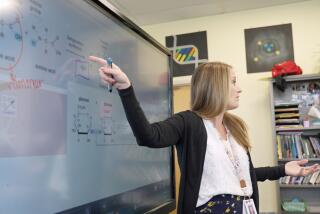Centinela Valley Starts 3-Year Program to Update Math Courses
The Centinela Valley Union High School District has decided to launch a three-year program to update its math teaching methods after being told that its current curriculum and approach don’t add up for many computer-age students. Supt. McKinley Nash said the effort, which began last week with a two-hour workshop for teachers, will involve restructuring the district’s math curriculum, retraining teachers and recruiting new talent.
“We saw that we weren’t doing the best we could do for our students,” he said.
The cost of the project, designed by a team of outside math experts, was estimated at $175,000 in each of the next three years. Most of the money will go for training staff in the new approaches.
Philip Daro, one of four mathematicians called in by Nash to study the district’s math curriculum, said some Centinela Valley teachers have expressed skepticism about the project, while others are enthusiastic.
“It’s understandable that teachers who may have many years invested in the old methods of instruction may be reluctant to change course,” he said. “We believe they will be drawn to the new techniques as they become more familiar with them.”
Daro, head of the California Mathematics Project based at the University of California, Berkeley, said high schools throughout the state need to update their math programs. He directs a statewide project aimed at revising math programs so more students, particularly females and minorities, can master the subject.
Walter Denham, chief of the State Department of Education’s math and science division, praised Centinela Valley’s willingness to open its curriculum to critical appraisal by outside experts.
“So far as I know, Centinela Valley is the first in the state in a long while to undertake an effort on this scale targeted at a single subject,” he said. “We think it can become a model for other districts, although we recognize that other school needs have to be taken into account.”
Denham and two other mathematicians involved in Daro’s project completed the team, which began the evaluation at Centinela Valley last fall. They summarized their recommendations in a report to the Centinela Valley school board.
Rote Memorization of Rules
The report, written by Daro, described the district’s current math program as a “well-organized version of the mechanistic type popular in the 1960s and 1970s,” with its heavy emphasis on rote memorization of rules and procedures.
That kind of “clerical math” should be left to computers, the team report said, and students should spend most of their classroom time on fundamental concepts, such as variables and functions, and on working together to solve problems.
The “big, powerful ideas” of math are actually easier to learn and use than all those dull rules, the report said, especially when the ideas are presented as a unified whole, rather than as a “clutter of trivia” parceled out in daily lessons.
But talented teachers are needed to get math concepts across in a way that even average students can grasp, the report said, and Centinela, like many other districts, has a low percentage (30%) of math teachers who majored in the subject.
In practice, it said, the talented teachers are assigned to instruct the students taking college preparatory courses, while the most needy students are left to the least-prepared teachers.
As a result, math remains a closed gate, “denying equal access to college for many of Centinela Valley’s students, especially blacks and Hispanics,” the report said. Minority students make up 72% of the 6,000 students enrolled in the district, which has high schools in Lawndale and Hawthorne.
To open the gate for more students, the report urged the district to change its math curriculum to conform with newly emerging teaching techniques--such as the so-called “California State Framework” adopted by the National Council of Teachers of Mathematics--and start instructing its teachers on the latest techniques.
More to Read
Sign up for Essential California
The most important California stories and recommendations in your inbox every morning.
You may occasionally receive promotional content from the Los Angeles Times.










